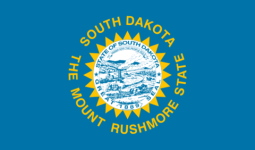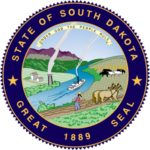South Dakota
South Dakota is a state located in the Midwestern region of the United States. It is bordered to the west by Wyoming and Montana, the north by North Dakota, the east by Minnesota and Iowa, and to the south by Nebraska.
- ABBREVIATION: SD
- NICKNAME: Mount Rushmore State
- POPULATION: 844,877 (2013 est.)
- CAPITAL: Pierre
- STATE BIRD: Ring-Necked Pheasant
- STATE FLOWER: American Pasque Flower
- AREA: 77,116 sq. mi.
- TIME ZONE: Eastern half: Central, – western half: Mountain
- ENTERED UNION: Nov. 2, 1889
- ALTITUDE: High, 7,244 ft. Harney Peak
- CLIMATE: Hot summers, cold winters. Adequate rainfall during growing season; winter blizzards.


Divided by the mighty Missouri, South Dakota contains four of the six major dams which will eventually control the river’s relentless flow, providing massive flood protection in the vast valley basin and simultaneously distributing cheap power and water for irrigation. To the west of the Missouri, South Dakota is a land of short grass where herds of cattle thrive, while to the east stretches an expanse of fertile plains where oats, corn, and spring wheat flourish. Agriculture has historically been a key component of the South Dakota economy and is it’s largest industry, about 90% of South Dakota is farmland.
Mining was once a major industry in South Dakota. The mile-high city of Lead (pronounced Leed) is located in what was once known as “the richest 100 square miles on earth”. Gold was discovered around 1876 which eventually led to the “Homestake Mine”, the largest, deepest, and most productive gold mine in the Western Hemisphere. The mine closed in 2001-2002, but the company town of Lead still remains; it was added to the National Register of Historic Places in 1974. Gold mining activity still exists in South Dakota, but on a minor scale compared to its ‘golden era’.

Tourism is the new ‘Gold’ in South Dakota. In 2006, travelers spent nearly $865 million across the state. Tourism is South Dakota’s second-largest industry, and Mount Rushmore is the state’s top tourist attraction. The Mount Rushmore National Memorial draws millions of visitors each year from around the world. The Sturgis Motorcycle Rally is held annually in Sturgis, usually during the first full week of August. The City of Sturgis has calculated that the Rally brings in over $800 million to South Dakota annually. To a lesser extent, the under construction Crazy Horse Memorial is also a destination for South Dakota tourist, as well as Badlands National Park, Black Hills National Forest, and the Jewel Cave National Monument, to name a just few.
FUN FACTS:
- Petrified Wood Park in Lemmon is the largest park of its kind in the world. Fossils and petrified wood are arranged in unusual shapes, including a castle and pyramids.
- South Dakota is the home of the Dakota, Lakota, and Nakota tribes, which together make up the Sioux Nation.
- The world’s largest, most complete, and best preserved specimen of Tyrannosaurus Rex discovered to date (2001) was unearthed on the Cheyenne River Indian Reservation in 1990. It was named Sue after the fossil hunter who found it.
- In 1959, with the addition of Alaska and Hawaii to the Union, the geographic center of the United States moved from Lebanon, Kansas, to a point near Belle Fourche, South Dakota.
- The 6,200-foot Mount Rushmore was created in 1927 by sculptor Gutzon Borglum for $1 million. It took him 14 years to create.
- The Missouri River cuts through the center of the state.
